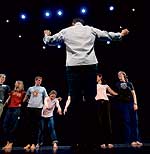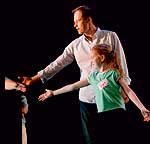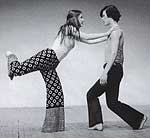The John Show
A string of choreography successes for John Carrafa ’76 puts him on Broadway’s center stage.
by Alana Watkins ’99 Photos by Phyllis Graber Jensen
John Carrafa ’76 walks into a coffee shop on Manhattan’s Upper West Side with an iPod in hand. With a lanky frame and sorta-innocent features that once prompted Richard Avedon to dub him “the babyface ax murderer,” Carrafa moves like the dancer he was, seeming to flow toward a seat. Motioning toward the iPod, he sits down, wipes the rain from his wire-framed glasses and says, “Do you have one of these? They’re awesome!”

Carrafa, photographed near his Amsterdam Avenue apartment.
Perhaps you can judge a man by his iPod, and Carrafa’s is stored with the music of the Beach Boys, more than 600 songs — studio sessions, outtakes, various other versions. Neither surfer dude nor Brian Wilson wannabe, Carrafa struts New York City listening to the Beach Boys to prepare for a new musical, Good Vibrations, to open in the coming season on Broadway for Carrafa, the show’s director, choreographer, and co-conceiver.
Since the 1990s, Carrafa has choreographed in nearly every entertainment medium: theater, film, television, even halftime shows for the National Basketball Association. But as director and choreographer for Good Vibrations, Carrafa steps into rare company.
“It’s incredibly unusual for a choreographer to be given the opportunity to direct a Broadway show,” says classmate Suzanne Carbonneau ’76, a dance critic, dance historian, and associate professor at George Mason University. “It’s a statement of multi-million dollar confidence.”
At the moment, Good Vibrations — a pop opera that follows four characters chasing their dreams to California, a fantasia on the themes of Beach Boys music (“a party,” Caraffa says) — is the only thing on his plate. He’s made trips to California to research surfing culture, even getting help from an unlikely source: his Bates dance teacher, Marcy Plavin, who put him in touch with her niece’s husband, filmmaker Stacy Peralta, who documented surf culture in Riding Giants.
Indeed, after decades of taking whatever job came along, Carrafa has reached an enviable position: He turns down jobs he doesn’t want.
The big splash came in 2002, when Carrafa was nominated for two Tony Awards, one for his choreography of Into the Woods, the other for his choreography of Urinetown. Carrafa was only the third person ever to be nominated twice in the choreographer category in the same year. “Suddenly everyone knows me on Broadway,” he says. “I feel like now I’m going to get more opportunities because people will say, ‘We should let this guy do what he does.'”
With typically understated self-confidence, Carrafa says the Tony nominations and the chance to direct a Broadway show simply recognize his years slogging it out. “I’ve been on the sidelines,” he says. “It’s always been about others, to help them and support them. It hasn’t been about the John Show. Now, it’s really about what I have to say.”
Carrafa’s love affair with dance began at Bates under Plavin and burned bright for 10 years as a dancer with the renowned Twyla Tharp Company. He says he wanted to become the greatest dancer in the world, but in some ways his was an unconsummated affair. “I was a priest, I was a nun,” he says. “I didn’t do anything but eat, sleep, or dance.” In the end, the existence was too passive. “Being a dancer is about following the music, doing what the choreographer says, being a vessel,” he says. “I had been a vessel for other people’s inspiration, not my own.”

At Bates, John Carrafa '76 helps choreograph alumni dancers and the retirement celebration for mentor Marcy Plavin.
So he stopped dancing. Choreography seemed like the logical next step, but Carrafa was at first ambivalent about the opportunities to tell stories through the somewhat narrow boundaries of choreography. Initially, he used choreography to work his way up in the business, taking on small movies and off-Broadway productions. “Anything that had some element of staging,” he says. In the early 1990s, he took time off to re-evaluate his career, cooking at an Upper West Side restaurant (“I’m Italian. It comes with the territory,” he says). He wanted to write, and used the medium to figure out what exactly he wanted to do.
“It’s a struggle to do something that means something to me and to figure out what does mean something to me,” Carrafa says.
He jumped back into choreography with a small film job in Los Angeles, then as choreographer of the off-Broadway show (later on Broadway and film) Love! Valour! Compassion! Through the 1990s and into recent times, he has also taught actors to dance, working with Robert DeNiro (Analyze That) as well as Pierce Brosnan and Renee Russo (for the dance-floor seduction scene in The Thomas Crown Affair), among others.
“He’s brilliant at working with people, getting them to relax, getting them to deliver, getting them to give,”

Carrafa is shown at Bates with Hope, daughter of Karen Foster French '85.
says dancer Greg Schanuel, a longtime friend.Carrafa’s film experience left him believing that motion pictures stumble when it comes to dance. “My passion is to make dance moves or numbers that make the audience want to stand up and scream,” he says. “It’s rare that anyone’s been able to do that in film.”
(Carrafa does have a list of stand-and-scream moments from theater and film: the “Bottle Dance” in Fiddler on the Roof; “Beat Me Daddy Eight to the Bar” from Big Deal by Bob Fosse; “Hey Big Spender” by Fosse from Sweet Charity; Fred Astaire and Cyd Charisse in the park in The Bandwagon; John Travolta and Uma Thurman dancing at Jackrabbit Slim’s in Pulp Fiction; and most recently, the movie You Got Served, which Carrafa says has some of the best dance numbers on film.)
But Carrafa’s dance reputation came not from helping A-list celebs hoof their way through a few scenes but from his choreography of an odorously named and decidedly unusual musical: Urinetown. Debuting in 1999 at the New York International Fringe Festival, Urinetown would earn 10 Tony nominations in 2002 and win three. Carrafa, some say, is the reason the show bowled over critics and audiences. “Urinetown would not have gone anywhere without John,” Plavin says.
And Carbonneau makes the point that the story elements of Urinetown flow from the choreography. “The choreography was incredibly witty and replete with references to other shows” — West Side Story and Chicago, among them. “The book [of Urinetown] was clever, but the visuals were just as important. John didn’t come in and just add the moves — they’re an intrinsic part of the show that can’t be separated.”
Despite the enormous success of Urinetown, Carrafa feels his career has just begun. “So far it’s all been learning,” he says. Perhaps that’s the best way — call it a learning experience — to describe one of Carrafa’s follow-up projects to Urinetown, late 2002’s Dance of the Vampires, a Broadway musical that closed in January 2003 after just 56 performances. Asked about the play’s lack of success (one reviewer wrote, “This is a show about vampires, and it sucks”), Carrafa begged to differ. “I consider it the most successful venture of my career,” he says. “I took the job to learn and learned more than most learn in a lifetime about the creation of a new musical.”
An ability to learn sets him apart, Carbonneau says. “John has the technical chops, but he also has an intellectual life. His work is smart, historically informed, and witty. You can see ballet and modern dance in his work, but also the Lindy hop and the Charleston. He chooses things from throughout history and around the world and does something unique.”
Even as Good Vibrations is set to open, Carrafa’s talents will be featured in an entertainment medium far removed from the sweat of Broadway dance. For Robert Zemekis’ The Polar Express, a computer-generated movie based on the popular children’s Christmas book and starring Tom Hanks, Zemekis turned to Carrafa, who provided choreography as well as movements for several of the animated characters.
He’s also working on skills in a whole other arena. Perhaps retaining something from the monomaniacal dancer’s life of two decades ago, Carrafa says he wants to better integrate his personal and professional lives over the next few years. “That’s my fantasy, having a really cozy home life. I want to marry somebody really, really nice and have about 12 kids,” he says with a laugh. “Finding that balance — I haven’t done that yet. I’m just learning.”
For now, however, Carrafa remains wholly captivated by his work in theater, how he can “open people’s minds. That’s a valuable occupation to have. But if I’m not doing it to blow people’s minds, then it’s not fulfilling that purpose.”
“There’s a way in theater to build a dance or a number that starts somewhere and you think ‘Oh, that’s good,'” he continues. “And then it goes to another place, and another place, and then the audience is saying, ‘Oh my God, that’s unbelievable!’ If I can do that a couple of times, it will be a good life.”
Carrafa on Plavin
“Marcy Plavin taught me that dance deserved the respect that I was paying to my academic studies. She instilled in me a dedication to this art form as an intellectual pursuit that equaled my original goal, to be a medical doctor. Like all great teachers, Marcy opened a window for me into a new workd. She gave me the confidence to ardently pursue my wildest ideas. All the crazy things I do, even today, blame her. She started it.” — John Carrafa ’76 on the influence of Marcy Plavin, founder of the Bates College Modern Dance Company (1969) , who retires this year after teaching dance since 1965. Click here to link to the full story on Marcy Plavin in Quad Angles
Carrafa on stage and screen

As a student, dancing with Mary Griffin '73 in 1973.
Broadway
Dance of the Vampires (2002-03), choreographer
Into the Woods (2002), choreographer
Dance of Death (2001-02), musical staging
Urinetown (2001-04), musical staging
Dirty Blonde (2000-01), musical staging
Love!Valour!Compassion! (1995), choreographer
Singin’ in the Rain (1985-86), performer, assistant, choreographer
Motion Pictures
Polar Express (2004), choreographer
Thomas Crown Affair (1999), choreographer
Love!Valour!Compassion! (1997), choreographer
Mocking the Cosmos (1996), choreographer
It Could Happen to You (1994), choreographer
The Night We Never Met (1993), choreographer
Sing (1989), dancer, choreographer
Rooftops (1989), choreographer
Amadeus (1984), dancer
RagTime (1981), dancer, assistant choreographer